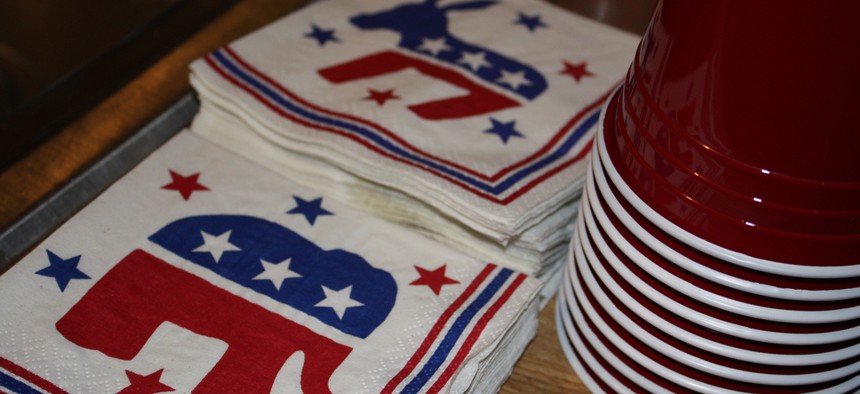Why Americans Are Divided Between the Two Parties
The public likes Democrats more than Republicans. But it also hates Obamacare more than it loves it.
After President Obama’s rather comfortable victory over Mitt Romney last November, some Democrats thought the president could defy the laws of political gravity. They are now disappointed. So are Republicans who thought that controversies over Benghazi, the Internal Revenue Service, and domestic surveillance would bring Obama’s approval ratings crashing down into the 30s, if not the 20s, as has happened with some second-term presidents. Obama’s approval numbers have been on a very gradual decline and are now at the political equilibrium point where equal numbers of Americans approve and disapprove.
In Gallup polling the week of June 17-23, 46 percent approved and disapproved of Obama’s performance. If you take an average of the most recent polls by ABC News/Washington Post, CBS News/New York Times, CNN, Fox News, Pew Research, and NBC News/Wall Street Journal, all conducted either this month or last, Obama’s approval is a point higher, 47 percent, with a disapproval of, you guessed it, 47 percent. This puts Obama’s job-approval rating at basically the same place as George W. Bush’s at this point in his second term and behind the 55 percent and 58 percent levels where Bill Clinton and Ronald Reagan were, respectively, at this stage.
The good news for Obama is that the economy is getting better. The bad news is that Washington and much of the news coverage in recent weeks have been focused on just about everything but the economy.
Of course, Republicans not only want to see Obama’s numbers drop but their party’s favorability ratings climb. So far, that hasn’t happened. Gallup polling shows that the percentage of Americans viewing the Republican Party favorably has been declining since the beginning of 2011. Most recently, in a June 1-4 poll, 39 percent rated the party favorably, 53 percent unfavorably, compared with 46 percent who saw the Democratic Party favorably and 48 percent unfavorably (which is certainly nothing for Democrats to cheer about). The other two major national polls asking about party ratings in the past two months indicated that the GOP’s brand damage has continued. The Pew Research Center pegged Democrats with 51/45 favorable/unfavorable ratings, in contrast to Republicans’ 39/53 ratings. The NBC/Wall Street Journal poll put Democrats at 39/37 and Republicans at 32/41. Average the three polls together, and 45 percent gave Democrats a favorable rating and 43 percent unfavorable, compared with 37 percent with favorable views of the Republican Party and 50 percent unfavorable.
Even stipulating for a moment that the Republican brand is badly damaged, we can’t say that this will be the determining factor in the 2014 midterm elections. We know that in recent years the kinds of voters who have boosted Democrats in presidential years have a track record of staying home in midterms. Even some Democrats totally enamored with Obama are unlikely to show up and vote for a congressional candidate whom they don’t know.
Another potentially important issue is the Affordable Care Act, aka “Obamacare.” Unquestionably health care, aided by a weak economy, was most responsible for Democrats in 2010 losing their House majority and a half-dozen seats in the Senate. In 2009 and 2010, during the height of the health care debate, some people decided that Obama’s proposal was terrific, many thought it was terrible, while still others were ambivalent. Few minds were changed in either direction during 2011 or 2012.
But what about 2013 and 2014, as more elements become operative? The Kaiser Family Foundation’s health tracking poll asks about current attitudes toward the health care law. At the moment, 35 percent have a favorable impression of the law, 43 percent have an unfavorable impression, and 23 percent remain undecided. Equally important, twice as many Americans, 30 percent, have a “very unfavorable” view, compared with just 15 percent who have a “very favorable” one. Indeed, the people who don’t like the ACA hate it (30 percent very unfavorable, 13 percent somewhat unfavorable), but the people who like it don’t necessarily love it (15 percent very favorable, 20 percent somewhat favorable). In recent months the unfavorable share has been gradually increasing, and the favorable share has been in a slow slide, although nothing earth-shattering. The key is those undecided in the middle, many of whom are cross-pressured on the issue. They may think we needed to do something about the affordability and access of health care, but they aren’t sure whether this law was the right way to do it.
The thing that makes it difficult for Republicans to capitalize on the ACA issue is that many in the party are so blinded by their hate for Obama and Obamacare that only the word “repeal” comes out of their mouths. This is something that is virtually impossible to achieve unless Republicans get at least 60 seats in the Senate, which is very unlikely to happen anytime soon. Smarter Republicans would say that “we need to fix Obamacare,” or that “we need to make changes to the law so it won’t screw up health care.” These sorts of arguments are more likely to resonate with voters outside of the party’s conservative base (keeping in mind that only 35 percent of Americans identify themselves as conservatives—25 percent are liberal, 40 percent moderate, according to the 2012 exit polls, roughly the same as in other national polls).
So, at the halfway point of 2013, we’re at a place where we still don’t know what the dominant theme will be in the 2014 midterm elections, and that probably won’t change until this fall, at the earliest.
This article appears in the June 29, 2013, edition of National Journal as Split Verdict.



